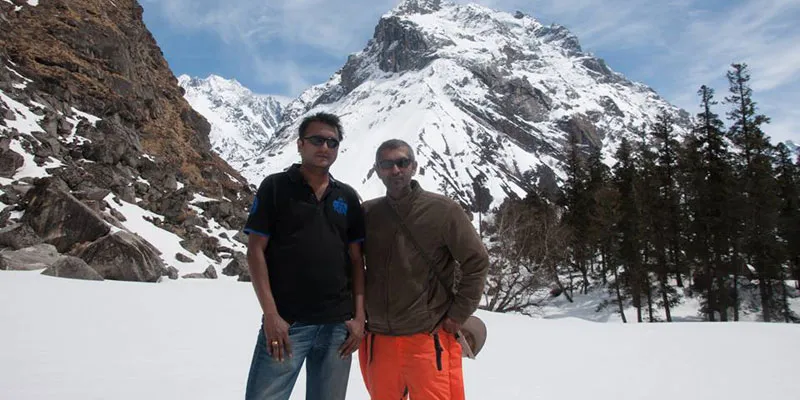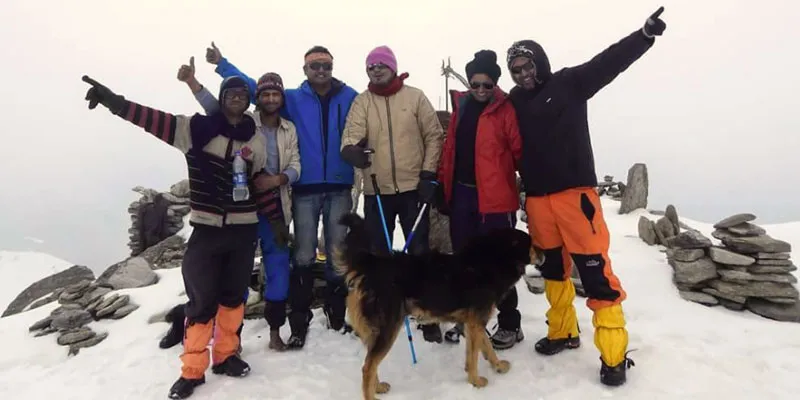2 corporate ‘escapees’ start up adventure travel company Altitude Syndrome
Adventure travel company, Altitude Syndrome was launched early this year by two avid trekkers who quit corporate jobs to pursue their vision of offering the kind of leisurely, immersive trekking experiences that they themselves enjoy.
Judging by the initial response to the business, their vision seems to be resonating with both seasoned and wannabe trekkers. In the first half of this year, Altitude Syndrome organized six treks in Uttarakhand and has another seven lined up in the next few months in Bhutan, Uttarakhand, and Nepal.

It all started with a name
Sometime late last year, Sajish GP—trekker, blogger, and co-founder of training company Prometis—was working in his tiny office when the name “Altitude Syndrome” came to him out of nowhere and struck him, to use a cliché, like a bolt of lightning. “Though I had been toying with the idea of doing something in the trekking/adventure travel space for some time then, I had not given it any serious thought till that point. But that evening when the name hit me out of the blue, I felt like I just had to do something with that name and follow through on my long-cherished dream, like, right now.” Sajish immediately went online to see if the domain name was available and was amazed to find that it was. He booked the name at once and there was no looking back after that.
Sajish found an enthusiastic partner for Altitude Syndrome in his former college mate, trekking buddy, and Prometis Co-founder Randeep Hari. Also a corporate escapee, Randeep had trekked with Sajish on several occasions and had always enjoyed the experience. He also noticed how most friends who trekked with them came back asking when they could trek together again. “So when Sajish came up with the idea, I got on board immediately. I saw it as an opportunity to turn into my job what I love doing anyway,” says Randeep.
Value proposition – a fun, potentially life-changing experience
“Altitude Syndrome’s business model is based on the company’s mission to introduce as many people as possible to the sheer addictive nature of mountains,” says Sajish.
The company aims to achieve this goal by adopting practices that align with their driving philosophy that “trekking is not about ticking off a destination in your list.”
Some of their key differentiators are:
- Longer trip itineraries that allow buffers for bad weather and accommodate inexperienced trekkers: Randeep says, “We want to make sure that even the slowest person enjoys the trek and makes it to the destination. A lot of people feel that they can’t go trekking because they are not a certain age or because they are not as fit as the next guy. But a trek is just a walk in the woods and we try to make everyone feel that they can go trekking if they want to.”
- Small group sizes: “From our experience we’ve found that 12 is the ideal number for most treks, though we do take groups as small as five and as large as 15,” says Sajish. The company believes that limiting the size of the group enhances the trekking experience (“Imagine having to line up outside toilet tents in biting cold with 20-30 people!” quips Sajish) and also reduces the impact on the environment.
- Cultural experiences: Most treks are planned to coincide with local festivals or arrangements are made for groups to stay with or share food and interact with local families.
- Handpicked teams of support staff (guides, porters, cooks, etc.): Altitude Syndrome has tie-ups with support teams across several regions in the Himalayas and is in the process of identifying strategic partners in destinations across the globe.
- Multi-course meals (available on most treks)
The founders agree that these practices have an impact on Altitude Syndrome’s pricing, but say that their tours are priced just a couple of price points above those of the average tour operator and offer a premium experience for far less than what the high-end players charge. Sajish says, “The options currently available are either extremely premium or budget. We offer something in between for 25-50-year-old professionals who are looking for a comfortable, yet authentic experience.”

Altitude Syndrome offers both pre-scheduled and customized treks for individuals, private groups, and corporates.
Getting the word out
Altitude Syndrome is currently using their website and Facebook page for marketing. It also relies on word-of-mouth and repeat business from customers.
The roadmap
Sajish and Randeep are working on replicating their model in destinations abroad. While their current focus is the Himalayas, the company is building teams and networks in various locations in India and abroad and is planning on bringing in more cultural experiences. For instance, one of their new offerings is a “Yoga Trek” to Dayara Bugyal in Uttarakhand. However, they are cautious about growing the business beyond a point. “We aim to remain a boutique business. Personal attention and customization are our main value propositions and we will risk diluting that if we scale up too much too soon,” says Sajish.
Funding: putting money where the heart is
Altitude Syndrome is currently funding the business through bootstrapping and through contributions from family and friends. “We were happy to find that several people—friends, family, and potential customers—believed in the concept and wanted to contribute. Some investors came on board for a promise of free treks at some point in the future, while others wanted to be part of this venture simply because they liked the idea,” says Sajish.
As for future funding plans, all Randeep will say is: “We’ll see. We don’t want to raise funds for the sake of it. At some point if we feel the need for external funding we will look for someone who is also passionate about travelling. We’re still learning the ropes in this industry and would like to take at least another year to see where we’re headed.” Sajish chimes in with a smile, “We’re headed North, that’s for sure.”







